Key takeaways:
- Experimental sound design redefines creativity by exploring unconventional sounds and emotional depth, emphasizing the significance of silence.
- Utilizing a variety of tools, from software to hardware, allows for unique sound manipulation and enhances the creative process.
- Layering sounds and contrasting frequencies create rich auditory experiences, inviting listeners to engage emotionally and reflectively.
- Collaboration with other artists enriches sound design, fostering new ideas and pushing creative boundaries through shared perspectives.

Understanding experimental sound design
Experimental sound design is all about breaking boundaries and reimagining how we create and perceive sound. I remember the first time I layered unconventional sounds—a metal spoon clinking against glass combined with bird calls. It felt like I was unlocking a whole new world of auditory possibilities, prompting me to wonder: how often do we limit our creativity by sticking to traditional methods?
Diving deeper into this realm reveals an exciting exploration of textures and emotions tied to sound. I’ve found that even silence can be an integral part of sound design, allowing moments for reflection and impact. As I play with various sounds, I often ask myself: what feelings does this sound evoke? The answers can lead me down surprising paths, unveiling a complex relationship between sound and the human experience.
Ultimately, experimental sound design invites us to redefine our understanding of music and audio. My experiences have taught me that each sound holds a story, waiting to be uncovered. What might your journey into this world reveal about the sounds that surround you?
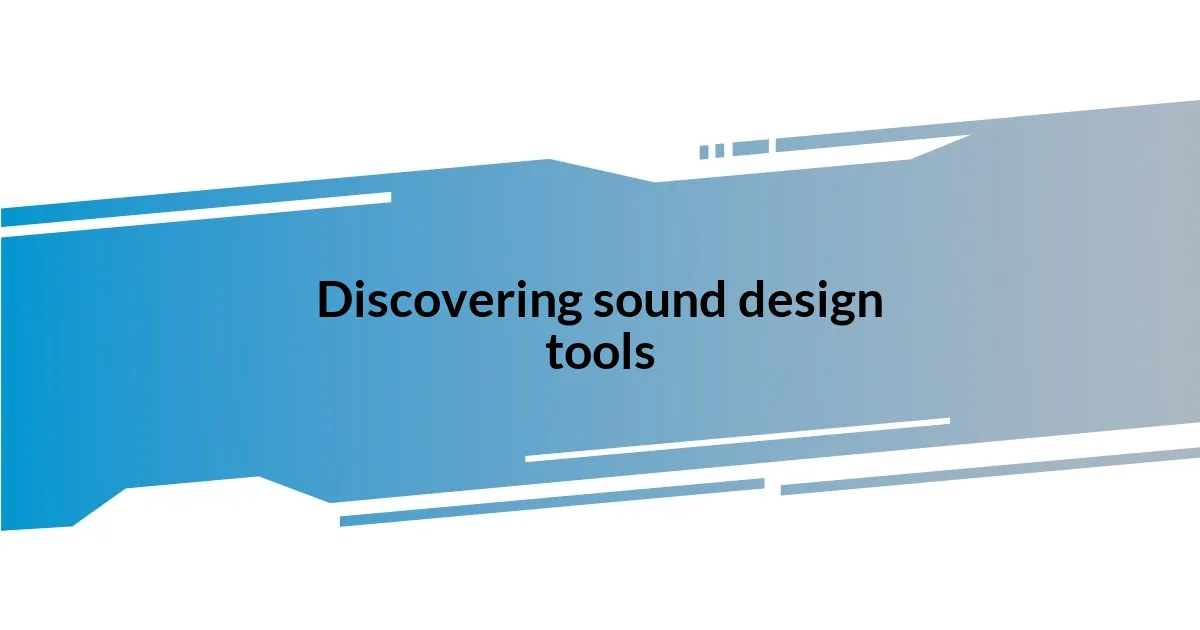
Discovering sound design tools
Discovering sound design tools has been a transformative experience for me. The initial rush of downloading my first audio editing software was exhilarating. It opened up a treasure trove of possibilities. I remember experiencing a mixture of excitement and intimidation as I navigated through endless buttons and options. Each tool seemed like a key, waiting to unlock unique soundscapes.
As I explored plugins, I found myself gravitating towards ones that allowed for granular synthesis. The ability to manipulate sound at such a detailed level was fascinating. I experimented with a plugin that transformed everyday noises into something ethereal. One night, I recorded the hum of my refrigerator, modified it, and ended up creating a hauntingly beautiful drone. It was a stark reminder of how ordinary sounds can morph into extraordinary auditory experiences.
I also delved into hardware tools, like synthesizers, that offered tactile engagement. There’s something incredibly rewarding about twisting knobs and pulling sliders to create sound. I vividly recall spending hours in a local music shop, losing track of time while experimenting with an analog synth. It felt akin to painting with sound, each turn producing a new color in my audio palette.
| Type of Tool | Description |
|---|---|
| Software | Using programs to edit, layer, and synthesize sounds digitally. |
| Plugins | Additional software to enhance the capabilities of a digital audio workstation. |
| Hardware Synthesizers | Physical instruments that generate sounds through electronic processes. |
| Field Recorders | Devices used to capture sounds from the environment for later manipulation. |

Exploring unique sound sources
Exploring unique sound sources has led me to some surprisingly enriching experiences. One day, I found myself on a quest for inspiration in my own backyard. I began to manipulate sounds from nature—crunching leaves underfoot became a rhythmic percussive element, while the gentle rustle of wind through branches transformed into a soothing backdrop. I couldn’t help but notice the emotional depth these natural elements brought to my compositions. When I mixed them with an urban sound byte, like distant traffic, it created a beautiful juxtaposition, highlighting the connection between chaos and serenity.
The beauty of sound design lies in uncovering the extraordinary in the ordinary. Here are some fascinating sources I’ve experimented with:
- Kitchen Utensils: Tapping spoons, stirring pots, and the sounds of boiling water can create unexpected rhythms.
- Nature Elements: Bird calls, rustling leaves, and flowing water bring texture and organic warmth to compositions.
- Mechanical Sounds: The whir of a fan or the clanging of tools can add layers of industrial ambience.
- Human Voice: Using vocalizations like whispers or laughter can evoke intimacy and a wide array of emotions in your pieces.
- Found Objects: Items like bottles or cardboard boxes can be transformed into percussive instruments with the right technique.
Each sound source I explore adds a new layer to my understanding of what music can be. It’s almost like a treasure hunt, where every ordinary object hides unique potential waiting to be unveiled.
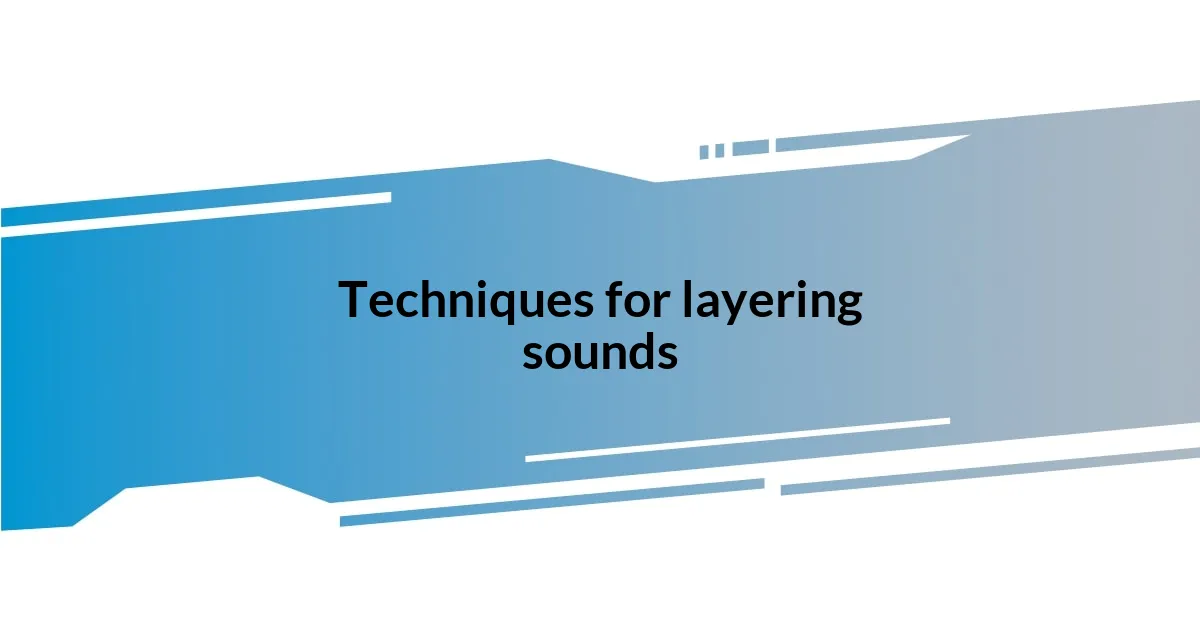
Techniques for layering sounds
Layering sounds is a technique that has dramatically changed the way I approach my compositions. One method I find particularly effective is starting with a foundational layer—like a soft drone or steady beat—before gradually building on it with additional textures. I vividly remember creating a track where I first laid down a simple piano melody, then added whispers and environmental sounds. The end result was mesmerizing, as each element contributed to a rich tapestry of sound that enveloped the listener.
Another technique I love is using contrasting frequencies. Mixing low bass notes with high-frequency chimes can evoke a unique emotional response. For instance, I once experimented by pairing deep, resonant tones of a didgeridoo with the delicate tinkling of glass harmonics. The fusion was captivating; it made the listeners not only feel the depth of sound but also reflect on the contrast. Doesn’t it evoke curiosity about what’s possible when we dare to combine seemingly incompatible elements?
I also often utilize ambient soundscapes as layers beneath my main elements. One winter evening, I sat by a snowy window recording the soft crunch of snow underfoot, and layered it beneath a haunting vocal track. The result was a wintery atmosphere that transported listeners to a serene, snowy landscape. It’s delightful to think about how layering distinct sounds can not only enhance a musical idea but also create a vivid narrative or scene that resonates emotionally with the audience.
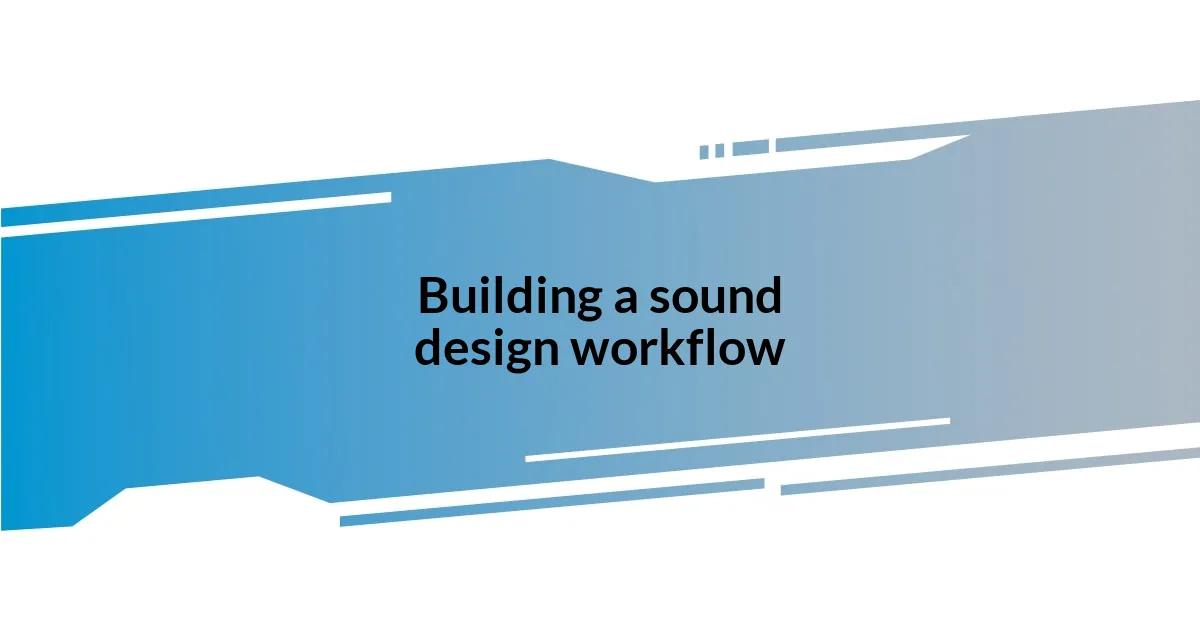
Building a sound design workflow
Building a sound design workflow is crucial for channeling creativity effectively. I’ve found that organizing my process into distinct stages—like brainstorming, recording, and editing—keeps me focused and productive. For instance, during a recent session, I started with a freewriting exercise that opened my mind to new ideas. It’s fascinating how jotting down initial thoughts can lead to unexpected sound sources or techniques that inspire my compositions.
Another key aspect of my workflow is creating a dedicated workspace. I remember setting up a cozy nook in my studio filled with my favorite instruments and recording gear. That physical space became my creative sanctuary. It was there that I discovered how the ambiance of a place can influence my work. Have you ever noticed how the right environment can spark your creativity? I often suggest trying different settings to see where your best ideas emerge.
Lastly, I always allow time for experimentation in my workflow. Setting aside specific days to just play around with sounds helps me break away from structured compositions. One afternoon, I decided to explore granular synthesis and was blown away by the textures I could create. It’s moments like these that remind me to embrace spontaneity. After all, isn’t it in the unplanned discoveries where the true magic often lies?
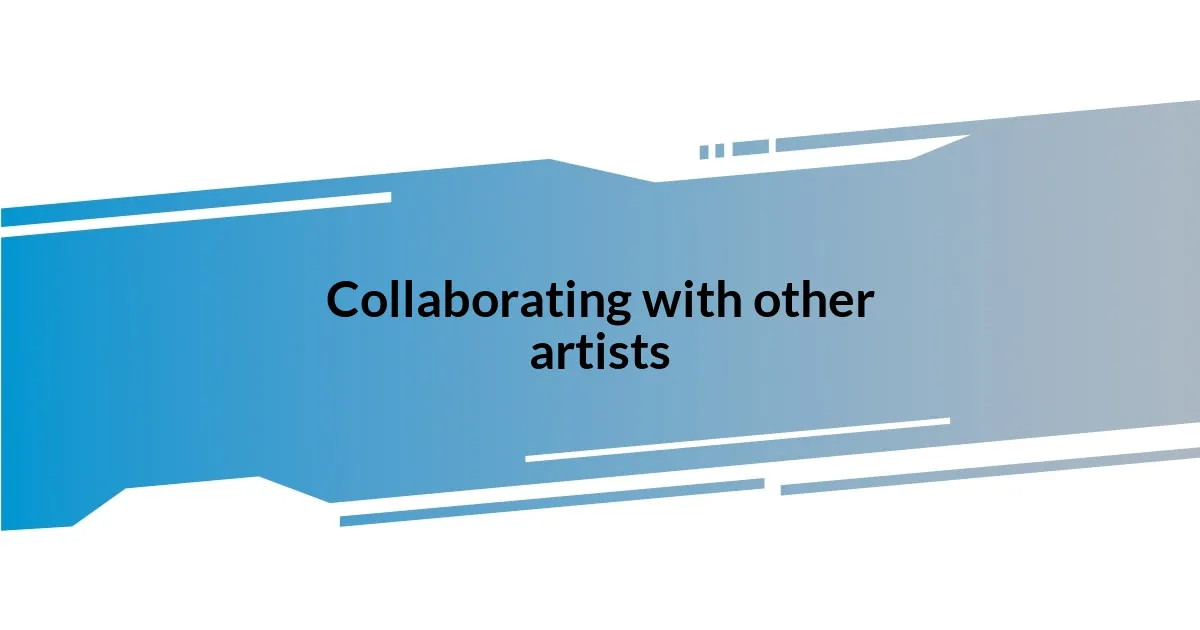
Collaborating with other artists
Collaborating with other artists has been one of the most enriching experiences in my journey into experimental sound design. I remember a particular project where I worked alongside a visual artist who specialized in installation art. As we exchanged ideas, I crafted sounds specifically tailored to complement her visuals, leading to an immersive installation that truly brought together sound and sight. This synergy not only deepened my appreciation for other mediums but also opened up new dimensions in my sound exploration.
There’s something magical about blending ideas with different perspectives; it’s like a creative spark that ignites inspiration. I recently teamed up with a fellow musician known for her vocal improvisation skills. I provided a soundscape filled with textures and layered rhythms, while she let her voice weave in and out, creating an evolving dialogue. Watching the way our distinct styles intermingled was like witnessing a new language emerge. Isn’t it incredible how collaboration can push the boundaries of our artistic comfort zones?
In another memorable collaboration, I joined forces with a filmmaker to score a short film. This experience taught me the importance of timing and pacing in sound design. I felt an adrenaline rush as I adjusted my sounds to enhance the emotion of each scene, knowing that my audio elements could make or break the viewer’s experience. Embracing the unique visions of my collaborators has transformed my approach to sound design and has driven me to be more adventurous in my creative choices. How has working with others inspired your own artistic journey?
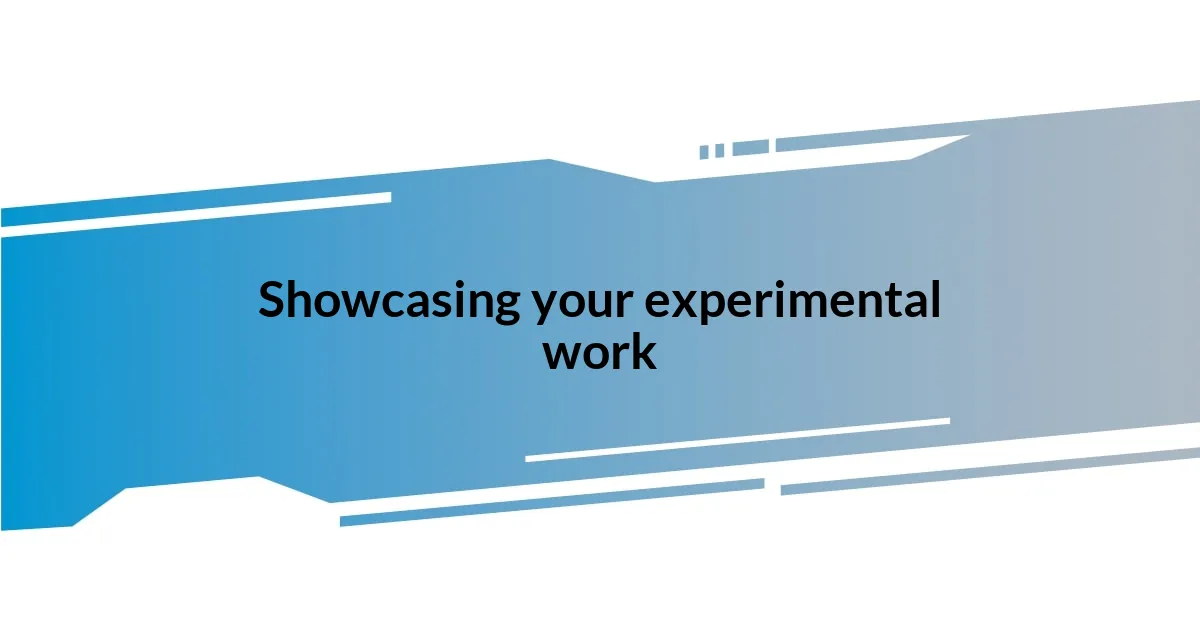
Showcasing your experimental work
Showcasing experimental work can be one of the most exciting parts of the creative process. I remember the first time I shared one of my compositions at a local art gallery event. I was gripped by a mix of excitement and anxiety as I set up my sound installation, wondering how others would perceive the unusual structures and textures I had created. That moment taught me the importance of not only presenting your work but inviting the audience into your world, allowing them to experience the sounds as living entities. Have you ever felt that thrill of sharing a piece you’ve poured your heart into?
Utilizing online platforms has become an invaluable resource for me in showcasing my work. I often post snippets of my sound experiments on social media, and engage with viewers who might take a moment to share their thoughts. Just last week, I posted a sound collage that blended field recordings with synthesized elements. The feedback was overwhelming—people connected with my exploration of urban environments versus natural soundscapes. It’s incredible how technology helps bridge the gap between artist and audience, fostering a sense of community. How do you prefer to share your creative outputs?
In addition to digital platforms, live performances have been transformative in showcasing my experimental work. I recall a particular gig where I performed a live score to a contemporary dance piece. As I watched the dancers interpret my sounds, I was captivated by the dialogue that emerged between movement and audio. It was like unveiling a new narrative in real time. This experience reinforced my belief that showcasing is as much about interaction as it is about presentation. Do you find that your work resonates differently in a live setting compared to a recorded format?